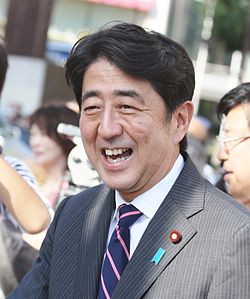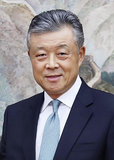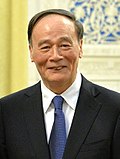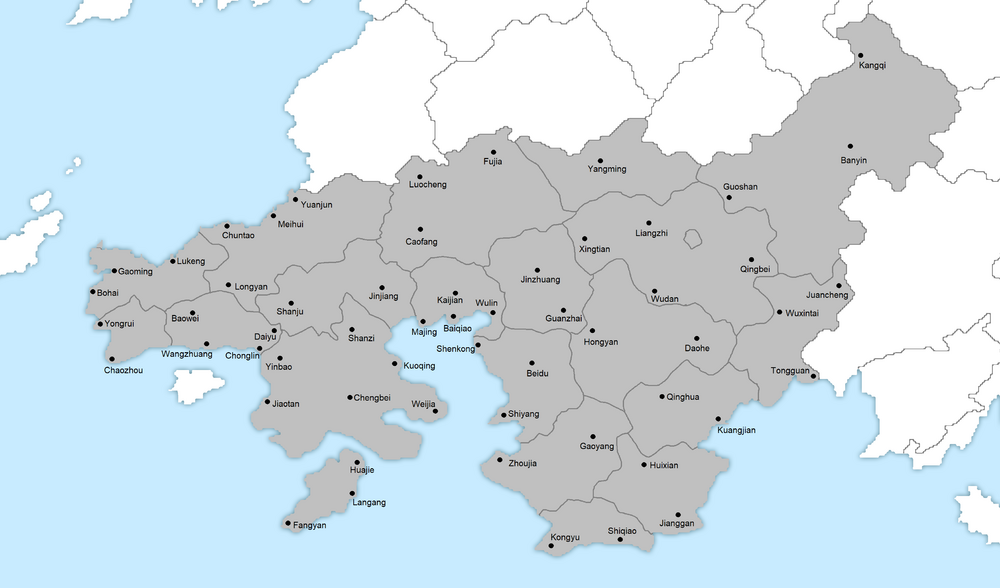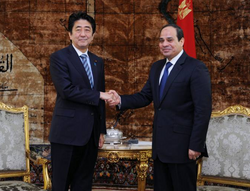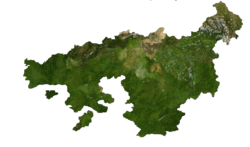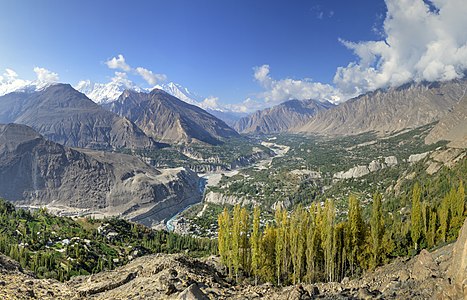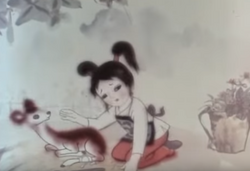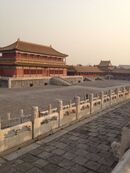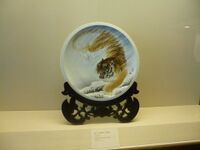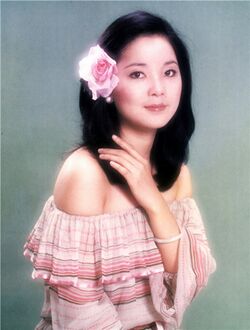Shangea
This article is incomplete because it is pending further input from participants, or it is a work-in-progress by one author. Please comment on this article's talk page to share your input, comments and questions. Note: To contribute to this article, you may need to seek help from the author(s) of this page. |
Auspicious Republic of Shangea 晓东吉祥共和国 Xiǎodōng Jíxiáng Gònghéguó | |
|---|---|
| Motto: 吉祥我国多么光芒万丈! How bright is our Auspicious Nation! National ideology: National Principlism | |
| Anthem: 胜利进行曲 Shènglì jìnxíngqǔ | |
| National seal · National Flower 晓东吉祥共和之玺 · 洋紫荆 (Bauhinia orchid) | |
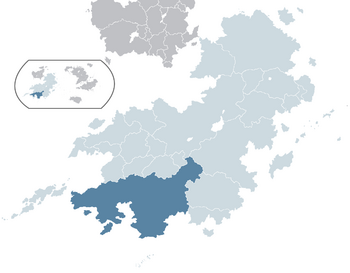 Location of Shangea in Coius | |
| Capital and largest city | Rongzhuo |
| Official languages | Shangean |
| Recognised regional languages | Chanwan, Paisha |
| Other | Ba, Shukin, Hohua, Dakatan |
| Ethnic groups (2013) | Shangean (74.4%) Chanwan (8.8%) Ba (4.3%) Shao (3.2%) Pala (1.7%) Ho Ne (1.5%) Irfanics (1.2%) Senrian (0.4%) Other (4.5%) |
| Demonym(s) | Shangean |
| Government | Unitary authoritarian socialist republic |
| Yuan Xiannian | |
• Premier | Wen Kezhi |
| Wang Hongzhi | |
| Tang Shanyuan | |
| Yi Shaoqing | |
| Legislature | Legislative Council |
| Establishment | |
| 1866 | |
| 20 September 1936 | |
| Area | |
• | 6,898,573 km2 (2,663,554 sq mi) |
| Population | |
• 2023 estimate | 745,173,574 |
| GDP (PPP) | estimate |
• Total | €11,685,066 million |
• Per capita | €15,681 |
| GDP (nominal) | estimate |
• Total | €6,380,176 million |
• Per capita | €8,562 |
| Gini | 39.8 medium |
| HDI | 0.744 high |
| Currency | Kuai (SHK) |
| Date format | yyy-mm-dd |
| Driving side | right |
| Calling code | +893 |
| ISO 3166 code | XI |
| Internet TLD | .sh |
The Auspicious Republic of Shangea (晓东国吉祥共和; Xiǎodōng Jíxiáng Gònghéguó) more commonly known as Shangea (晓东国; Xiǎodōngguó) is a nation in Coius bordering Kuthina to the east, the unrecognised republic of Heijiang to the southeast, Zomia and Hacyinia to the northeast, Zorasan to the north, Duran and Ansan to the northwest and in the west having maritime borders with Senria. It has a population of 745,173,574 with a nominal GDP of €6,380,176 million, with its capital and largest city being Rongzhuo located in the northeastern interior.
The home of the Shangean people, Shangea was first united by the Jianzhao Emperor in 650 BCE under the Xiang dynasty which ruled Shangea from 200 BCE to its collapse in 100 CE - during the rule of the Xiang dynasty Ruism became prevalent. Following the Xiang were the Song dynasty who introduced Zohism but collapsed in 400 CE when the country became politically unstable the period known as the "War of Four Kingdoms" as rival warlords and nobles fought for control. In 691 Shangea was united again under the Tao dynasty that oversaw the high point of Shangean literature and art. However, in 1356 the Tao dynasty was usurped by the Jiao clan who created the Jiao dynasty. Although initially wealthy, by the 1600's the Jiao dynasty was being torn apart by civil war and uprisings, most disastrously the Red Orchid Rebellion. In the late 1660's the dynasty finally collapsed, resulting in a Senrian warlord to conquer Shangea and create the Toki dynasty. However, the Toki's attempts to promote Senrian culture led to the development of Shangean nationalism.
During the late 1700’s and early 1800’s the Toki came under pressure from various colonial powers having to lease several port cities to countries such as Gaullica, Estmere and Etruria after the XXX war. A default of Shangean debts in 1847 led to foreign domination of the Shangean economy which started to cause substantial unrest. The continued failure to confront foreign powers led to a coalition of nobles and military officers in 1864 to stage the Restoration War with overthrew the Toki dynasty and led to the enthronement of the Xiyong Emperor who created the Heavenly Shangean Empire that oversaw a period of economic modernisation and semi-constitutional rule. During this period Shangea subjugated neighbouring states and as a result of Shangea's victory in the Etrurian-Shangean War became recognised as a great power in the process becoming aligned with Gaullica.
During the 1920's the Shangean state became more totalitarian under the Shanrong Emperor who entered Shangea into the Entente. Shangea launched an invasion of Senria in 1927 which led to the start of the Great War which saw Shangea participate in the Senrian Genocide and eventually be defeated by the forces of the Grand Alliance. The end of the Great War led to the overthrow of the monarchy and the creation of the Republic of Shangea. The republic was unpopular and soon destablised, leading to the Corrective Revolution that triggered the Shangean Civil War. The war saw rebel forces under Lu Keqian take power who created a dictatorship based on National Principlism. In 1984 Shangea began to marketise its economy, although the governing regime has maintained a monopoly on political power. This political hegemony was challenged in 2016 after sustained pro-democratic protests leading to the beginning of "Normalisation under Yuan Xiannian.
Shangea is currently a dictatorship, with its ceremonial head of state being State Chairman of the legislative branch of the government, the State Presidium, and the head of government being the Premier of the executive branch of government, the Council of Ministers. Since the 1980's Shangea has undertaken substantial political reforms although corruption has remained.
Shangea’s economy has been described as being in a system of state capitalism in which bureaucrats and corporations known as Caihongs are the cornerstones of the economy. Although part of the Shangean economy are state owned, it has undergone substantial neoliberalisation with most state owned corporations being privatised. Major Shangean exports include coal, rice, bauxite and coffee. Shangea is a member of the Community of Nations, and maintains relations with most other nations, both democratic and dictatorial, having especially close relations with Union of Zorasani Irfanic Republics as part of the Rongzhuo Strategic Protocol Organisation. Shangea's cultural influence, growing economy, interventionist foreign policy and possession of nuclear weapons makes it a great power on the world stage and a regional power in southern Coius, albeit one marked with rivalry with Senria.
Etymology
The name "Shangea" is an exonym , with the name of the country in fuhao is Xiǎodōng (/ɕiɑu tʊŋ/). The characters of 晓东 translate to "Dawning East". The characters were first used to describe Shangea by the Tao dynasty, and were during the Toki Sougunate recognised as the name of the country by Shangean nationalists, and was adopted as the name of the country following the Restoration Revolution.
The name Shangea was first used by the Etrurian explorer Alessandro Vespasi and is based on the Pardarian name for the Xiang dynasty shaangu (شیانگ) in 1224. It has since been the name to describe the country predominantly in Euclea.
The current name of Shangea, the "Auspicious Republic of Shangea" (晓东吉祥共和国; Xiǎodōng Jíxiáng Gònghéguó) was adopted following the Corrective Revolution in 1936.
History
Government and Politics
Shangea's political system is outlined in the 1942 constitution which has undergone numerous amendments since. Shangea is a unitary state organised on republican lines and containing a mix of presidential, parliamentary and socalist principles. Shangea is commonly seen as being an authoritarian state.
The highest body of the state is the State Presidium (国家常务委员会; guójiā chángwù wěiyuánhuì) which is led by a State Chairman (主席; zhǔxí) who serves as head of state. The State Presidium is the supreme executive and legislative body in Shangea, containing its chairman, the leaders of the four councils, the chief of the general staff and social affairs, foreign, security and finance ministers. The State Presidium appoints most members of the four councils which sits beneath the State Presidium which fulfil the roles of the executive, legislature, judiciary and civil service examination system.
The four subordinate branches to the State Presidium are the Executive Council (行政会; xíngzhèng huì) the Legislative Council (立法会; lìfǎ huì) the Judicial Council (司法会; sīfǎ huì) and the Examination Council (考試会; kǎoshì huì). The Executive Council which is led and appointed by a Premier (行政会总理; xíngzhèng huì zǒnglǐ) who functions as the head of government serves as a national cabinet of 20 ministries albeit with the State Presidium taking precedence in executive matters. Shangea maintains a four tier judiciary, with national, provincial, prefectureral and municipal courts with the Judicial Council serving as the supreme court being led by a Chief Justice. All judges, civil servants and politicians are picked from the Examination Council which is led by a president and based on the imperial examination system. The Legislative Council contains 750 seats with the majority elected by voters, and a minority either representing trade unions and peasant aid groups or coming from the military. The top leadership roles of state are the State Chairman, Premier and President of the Legislative Council with the incumbents being Yuan Xiannian, Wen Kezhi and Wang Hongzhi respectively.
Since 1940 Shangea has been an authoritarian state. Officially Shangea is a "disciplined democracy" (有纪律的民主; yǒu jìlǜ de mínzhǔ) with political parties being discouraged. Nevertheless a variety of political organisations have since reforms made during the 1980's emerged that function as political parties. The current main one of these is the Society for Restoring Benevolence which is considered to be the current "party of power". Most of these organisations adhere to a nationalist socialist ideology known as National Principlism (国家主体主义; guójiā zhǔtǐ zhǔyì) that seeks to uphold a centralised form of authoritarian socialism.
Political apathy is high due to government corruption, authoritarianism and a weak opposition. Unlike in most countries, ideological differences are not the main divides in Shangean politics, which is based much more on guanxi networks between politicians. Nevertheless opposition to these political factions which make up the governing networks coalesce into what is known as the dangwai movement that tend to promote more democratic governance compared to the governing cliques.
In 2016 after an economic slowdown and several high-profile corruption scandals a series of protests in favour of political reform resulted in the government of Yuan Xiannian and Jiang Zhongyu to launch a crackdown on protesters and the declaration of a state of emergency. International observers state this state of emergency, named "Normalisation" (正规化; zhèngguī huà) has turned Shangea into a de facto police state. In 2020, the government announced it sought to end Normalisation by January 2021 four years after its introduction with the passing of a new National Security Law and constitutional amendments.
Government
Officially the main executive body in Shangea is the Executive Council led by the Premier. The Executive Council is responsible for the implementation of the constitution and for the exercise of executive powers in implementing the decrees and general policies as outlined by the State Presidium, except for matters directly related to the State Presidium, who has the final say in all matters. The Executive Council is led by the premier and four coordinating ministers - International Relations, Finance and Economic Affairs, Social and Cultural Affairs and Security and Justice Affairs. Below the Coordinating Ministers are 35 regular ministers overseeing a wide array of portfolios.
The Premier appoints the members of the Executive Council and are themselves handpicked by the State Presidium, with a legislative vote needed to confirm appointments. All members of the Executive Council are approved by the Examination Council. The Premier, State Presidium and Examination Council have the authority to dismiss members of the Executive Council who can also be impeached by the Legislative Council.
The relationship between the State Presidium and the Executive Council is often unclear. According to convention the State Presidium leaves most day-to-day governing to the Executive Council whilst making most major policy decisions. Since the assumption of power by Yuan Xiannian the role of the State Presidium has been strengthened making them constitute the apex of decision making.
Legislature
The main legislative body of Shangea is the unicameral Legislative Council which consists of 750 delegates. 550 are elected in a single-member plurality system, 150 from trade unions and peasant mutual aid societies and 50 appointed by the military. The partial nature of the elected legislature is intended to represent the concept of "councilist democracy".
The Legislative Council is chaired by its President who oversees legislative sessions in a manner similar to a speaker. In 2008, a bipartisan legislative commission recommended the creation of legislative committees to better scrutinise government policy, although no such moves to formally establish committees have been attempted yet.
Any legislative delegate has the right to propose draft laws to the council, which must pass a simple majority vote to become formally part of the law. Despite this most successful draft laws have come from the government benches which has always maintained a legislative majority. The council has the right to amend the constitution if the government has a supermajority (two thirds of the total seats, 495) or can declare a referendum on a proposed constitutional amendment if it possesses a simple majority (over half of total seats, 376).
Currently the legislature is dominated by allies of State Chairman Yuan Xiannian from the Society for Restoring Benevolence. Opposition pro-democracy groups, who previously were elected to the legislature, have been mostly banned. Other groups in the Legislative Council include the Association for Promoting Democracy which is seen as far-right and the Movement for National Principlism which is more socialist leaning. All opposition parties are considered to be functionally pro-government.
Political parties and elections
The only national-level elections in Shangea are for the Legislative Council. Legislative Council elections are held every five years for 700 of the seats in the Legislative Council (550 elected by universal suffrage and 150 elected through functional constituencies). Voting for the directly-elected seats is done through a mixed member majoritarian system with 300 seats elected by single-member plurality voting and 250 members through party-list proportional representation. The proportional seats retain a 5% electoral threshold with the entire country treated as single constituency and are appropriated through the Li-Qiao method. Functional constituencies use single-member plurality voting. Provincial and municipal elections are similarly held every five years with posts within them also elected by first-past-the-post.
In 1989, Shangea implemented universal suffrage for the first time. In previous elections held between 1942-1984 voting had been restricted by literacy requirements for voters. Universal suffrage for women was introduced in Shangea in 1956. In 2014, electronic voting was introduced on a limited basis in Shangea subsequently being expanded for the 2017 snap election. Elections for the Legislative Council are staggered over a week with different provinces voting on different days.
Elections in Shangea are controversial as they are often accused of being subject to electoral fraud. Disfranchisement, vote buying and gerrymandering are the most common instances of electoral fraud in Shangea according to an International Council for Democracy report for the 2014 election, although ballot stuffing and voter intimidation have also been noted particularly during the 2017 snap election. The Shangean government has denied that it practices electoral fraud, albeit has admonished provincial officials for engaging it in.
Political parties are restricted in Shangea. Parties can only run for the Legislative Council if they operate nationally; that is run in all provinces of Shangea (with the exception of Jindao) and have membership in all provinces. Provincial parties must have at least 5,000 members. All parties must be approved by the Examination Council - between 2000 to 2014 the Examination Council allowed the registration of 22 political parties, with only 8 of those being new parties. Often in Shangea independent opposition parties and organisations find it difficult to be registered.
Since the foundation of the Auspicious Republic there has often been a single political party that has dominated state affairs to the extent that Shangea is considered either a one-party or dominant-party state. From 1942 to 1970 it was the Shangea Regeneration Society and from 1984 to 1988 the Constitutional Protection Society. From 1988 to 2006 there was no single dominant party due to a split in the elite. From 1989 to 1992 the CPS and the Concordance Democratic Party co-governed whilst from 1992 to 2006 the CDP was replaced by the National Association for Progress. In 2006 State Chairman Yuan Xiannian engineered the return of the dominant party state after merging the CPP and NAP into the currently ruling Society for Restoring Benevolence. All these parties were at various points named the "party of power" and all were largely made up of the bureaucratic, political and military elite supporting to varying degrees National Principlism. Often the party of power is supported by independent members of the Legislative Council giving them alongside support from military-appointed deputies a permanent majority in the chamber.
Opposition parties are divided into two categories. Some are considered to be satellite parties to the party of power whose function is to give the superficial image of a competitive democracy or represent certain interest groups outside the governing coalition, but in practice support the government. The other are known as dangwai ("outside the party") parties that sit in actual opposition to the party of power and its supporters. Dangwai parties often hold marginal seats in the Legislative Council lacking the administrative support of the party of power and often struggling to be elected in the functional constituencies. Since the start of normalisation in 2017 no dangwai parties sit in the Legislative Council with their members either being removed from office or defecting to either the ruling coalition or one of the satellite parties.
Judiciary
Shangean law has since 1940 been based on legalist traditions alongside socialist law from Valduvia. Previously Shangea maintained a strong Ruist judicial system based on the belief that the maintenance of tradition would be more effective in maintaining social order, but since the rise of Legalist philosophy since the 1940's the law has become more codified. Nevertheless, the rule of law in Shangea is subject to the will of the state which is seen as above the law.
The highest judicial authority in Shangea is the State Presidium which officially delegates responsibility of such authority to the Judicial Council whose members are appointed by the State Presidium. The Judicial Council sits above provincial, prefectural, county and township courts. The introduction of Normalisation in 2017 saw anti-sedition courts set up that had the power to fast-track prosecution for cases regarding sedition, treason and "anti-Shangean activity". Critics have labelled these as "kangeroo courts". In 2020, the government announced it hoped to merge these courts into the existing judiciary system. It also stated it would change the appointment of judges, which currently sits with the responsibility of provincial governments on a provincial level and the national government on a national level, to be instead solely the purview of the Judicial Council with approval from the State Presidium although nomination of judges will rest with provincial and national governments.
Shangea's legal system suffers from a lack of confidence in its effectiveness. Since the 1980's courts dealing with property law have seen marked improvement in the process of justice, although this effort remains slow on human right issues. Corruption within the system has also been on the decline as the system has come under increasing rationalisation. However jury trials in Shangea remain rare.
Subdivisions
Shangea is an unitary state with partial devolution consisting of 22 subdivisions overall all. 19 are provinces (省; shěng), 1 directly-administrated city (直辖市; zhíxiáshì), one autonomous province (自治省; zìzhì shěng) and one autonomous administrative territory (自治区; zìzhìqū).
Provinces each with their own regional government head by a chief minister (首席部長; shǒuxí bùzhǎng) with a provincial legislature known as provincial councils (省议会; shěng yìhuì) located in a regional capital. Provinces are further divided into prefectures (地级; dìjí) which are split either into urban districts (市辖区; shìxiáqǖ) and rural counties (县; xiàn). Districts are divided into sub-districts (街道; jiēdào) and counties into townships (乡; xiāng). The final level of organisation is a village 村; cūn).
Directly-administrated cities are governed by mayors (市长; shì zhǎng) with their legislatures being named biao's (表; biǎo) after the tables city elders used in ancient times. Unlike provinces the cities do not have district level administration instead being divided only into sub-districts and villages. Directly-administrated cities have slightly less autonomy then provinces being more subject to central government control.
Autonomous Provinces have a the same basic administrative structure of provinces having five prefectures (စီရင်စု; hcerain hcu). Chanwa does not have counties only retaining districts (ခရိုင်; hkarine) which are divided into rural townships (မြို့နယ်; myahoetnaal) and urban wards (ရပ်ကွက်; yatkwet) which are further split into villages (ကျေးရွာ; kyei-ywa). Autonomous provinces are led by governors (总督; zǒngdū) rather then chief ministers as is in the case of the provinces. Both autonomous provinces have bilingualism with regional languages (Chanwan and Paisha) in their official administration. Autonomous Provinces have more autonomy then provinces with the right to established their own official languages, constitutions and provincial anthems as well as greater rights over natural resources, external trade, regional security and internal budgets. However there tends to be cordial relations with the central government who have a strong role in autonomous provincial affairs leading to relatively coordinated action between the autonomous provinces and national government.
The single autonomous administrative territory, Kintao, has the highest degree of autonomy. It is divided into districts and below them suburbs. It is governed by a Chief Executive (特首; tèshǒu; chef de l'exécutif) with the legislature being the Biao or Legislative Council (conseil législatif). Kintao has autonomy over the majority of its affairs including the maintenance of its own legal system with Jindanese Law takes precedence over Shangean Law with the notable exception of the Shangean constitution. Kintao also maintains its own independent police force and currency, the Kintian nacar. Shangea still however retains the sole right to manage Kintao's foreign relations and national security.
| Province (省) | Administrative centre | Population | Province (省) | Administrative centre | Population |
|---|---|---|---|---|---|
| Anqian (安千) | Baiqiao (白壳) | 70,124,745 | Qigao (启皋) | Gaoming (杲溟) | 33,548,971 |
| Baozhou (宝州) | Shanju (山巨) | 31,258,985 | Rongzhuo (容㒂) | 18,457,725 | |
| Chanwa (安千) | Banyin (版因) | 22,266,392 | Tuohe (沱河) | Juancheng (鄄城) | 25,914,835 |
| Chengcao (成曹) | Shenkong (盛空) | 55,486,225 | Xiangshan (象山) | Jinzhuang (金装) | 18,258,763 |
| Dayong (大涌) | Yangming (杨铭) | 4,457,862 | Xufang (余坊) | Zhoujia (周家) | 24,758,631 |
| Heping (和平) | Wangzhuang (王庄) | 34,158,702 | Weishang (潍上) | Chaozhou (曹州) | 24,125,750 |
| Jianghui (江徽) | Jiangguan (𫮬管) | 22,415,874 | Wushan (吴山) | Qinghua (清华) | 38,452,365 |
| Kintao (金岛) | 6,814,557 | Yongba (永坝) | Lukeng (沦坈) | 44,872,540 | |
| Luoyuan (罗源) | Kuoqing (阔清) | 91,458,756 | Yunjin (郓津) | Hongyan (红岩) | 35,745,263 |
| Meishan (美山) | Liangzhi (亮值) | 27,410,221 | Zhijian (直建) | Kongyu (孔玉) | 32,457,865 |
| Nanqing (南青) | Langang (兰港) | 28,569,782 | Zhongan (中岸) | Wudan (乌丹) | 54,158,765 |
Armed forces and intelligence
Bottom row: A Kuoqing SS-17 main battle tank and a R-20 stealth air superiority fighter.
The armed forces of Shangea is known as the Shangean Revolutionary Army (晓东国救世軍; Xiǎodōng gémìng jūn) which is split into an army, navy, airforce and coast guard. The SRA currently has around 3,350,750 troops overall (685,500 active, 2,425,000 in reserve and 240,250 in paramilitary groups). The Chairperson of the State Preisidum is the commander-in-chief of the SRA, which answers to the Council of Ministers via Coordinating Minister of Security and Justice Affairs. Military affairs are primarily handled by the Joint Defence Council, a forum of military commanders who are subordinate to the Coordinating Minister of Security and Justice Affairs. Shangea currently spends 3.9% of its budget on the military.
The SRA were preceded by the Heavenly Shangean Army, which was the first modern army in Shangea. Following the abolition of the Heavenly Shangean Empire, the former Heavenly Shangean Army was renamed and consolidated into the Shangean Defence Army, which underwent modernisation in the 1930's. The victory of the SRA in the Shangean Civil War resulted in it becoming the national army. In the 1970's the defence forces underwent modernisation and since 2008 have undergone a further stage of modernisation and restructuring to be a more professional, efficient force. Shangea has committed to the development of its navy and airforce, which have been substantially modernised and expanded since 2008. The Shangean navy in particular is undergoing the transition from a green water to blue-water navy.
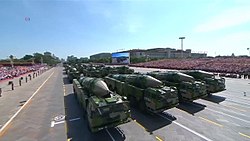
Shangea has a history of possessing weapons of mass destruction. During the 1930's it was known that Shangea had started to develop a stockpile of chemical weapons in the form of mustard gas, and during the 1950's started a biological warfare research programme. Shangea has resisted attempts to sign treaties that ban chemical weapons, and has been accused of possessing chemical and biological weapons such as sarin, nerve and mustard gas - however this has not been proven as of 2015. Shangea has admitted that it possess facilities that produce chemical and biological weapons, but asserts that they have been inactive since the mid-1990's. Following the development of Senrian nuclear weapons in 1964 Shangea refused to sign the Treaty of Shanbally and during the Coastal Crisis detonated its first nuclear weapon, Housheng. Since then Shangea has expanded its program massively, developing intermediate-range ballistic missiles in 2015. Shangea maintains an arsenal of up to 500 nuclear warheads with air, sea and land based delivery systems. Shangea refuses to implement a no first use policy maintaining a policy of strategic ambiguity on the use of their nuclear weapons.
Conscription - known as "Patriotic Civic Service" (爱国公民勤务; àiguó gōngmín qínwù) is theoretically enforced for all citizens between the ages of 18-21 for a period of 12 months. It was introduced in 1896 for all male citizens for a 24 month period with conscientious objection not being recognised by the government, with only those deemed "unfit for service" being exempted. In 1956 the government reformed the conscription law decreasing the time of service to 12 months and offering alternate service in a non-combatant role on medical grounds. The draft is rarely enforced in Shangea due to the number of volunteers often being sufficient in terms of recruitment - the majority of draftees are exempted by the government. Further professionalisation has led to calls to abolish conscription entirely and transfer to an all-volunteer professional force.
The main intelligence agency of Shangea is the Secetariat to Eliminate Counter-Revolution (书记处肅清反革命; shūjìchù sùqīng fǎngémìng) which handles both internal and external intelligence. The Shujichu is generally regarded as one of the most feared intelligence agencies in the world and is widely regarded as an effective secret police organisation. The Shujichu operate it's own military wing, the Revolutionary Guard (革命卫队; gémìng wèiduì), that acts as a gendarmerie force. The SRA operates its own intelligence arm, the Department of Communications and Information (通讯情报系; tōngxùn qíngbào xì). Another intelligence agency is Department 87 (系八十七; xì bāshíqī) which was created in 2001 to direct cyberwarfare operations.
Human Rights
Human rights in Shangea been a controversial topic between the Shangean government and a range of human rights groups as well as intergovernmental organisations such as the CNCHR and the International Council for Democracy. In recent years under the administration of Yuan Xiannian Shangea's human rights record has severely deteriorated particularly since the introduction of Normalisation compared to a generally improving record in the early 2000's.

Common criticisms of the Shangean human rights situation centre on the government's restrictions on freedom of speech, movement, assembly and religion. Despite political reform occurring since the Orchid Revolution in 1988 political freedom remains restricted with the ability to organise independent political parties being banned and censorship of sensitive topics common. In 2006 the Shangean government announced it would roll out a new system that would better regulate internet traffic in Shangea which according to a 2008 CNCHR report introduced "mass censorship" in the country.
Religious persecution is also a controversial topic in Shangea. The Shangean government officially promotes the practice of Zohism over what it deems to be "foreign and heretical religions" and as such implements repressive measures against monotheistic religions such as Sotirianity and Irfan. Ethnic repression in Shangea has also been an issue as foreign critics accuse Shangea of praticing Shangean chauvinism towards minority groups, particularly Chanwans.
The Shangean government has rejected criticism of its human rights record as being distorted by foreign biases. Shangean leaders have since the 1980's stressed that they follow a "Shangean approach to human rights" which necessitates that citizens are only granted rights if they abide by social responsibilities. This approach is based according to Shangean legal scholars on traditional Zohist conceptions of a harmonious society between the ruler and the ruled.
Since the start of Normalisation the human rights situation in Shangea is generally agreed to have declined to one of the poorest in the world, with the rule of law being undermined in favour of highly politicised courts and mass censorship and arrests being common alongside torture within detention facilities. According to a 2018 report by the CNCHR since the beginning of Normalisation measures in 1,500 people had been executed by the regime, 50,000 arrested and 140,000 either suspended or removed from their jobs. The Shangean Human Rights Monitor, considered to be one of the leading sources on human rights issues in Shangea, stated that moves in 2020 to officially end Normalisation were suspect and that the government intends to instead legislate them permenently through constitutional change.
Foreign relations
Shangea's foreign policy objectives since the mid-1940's were formalised in the "Three Fundamentals" - the isolation of Senria from international affairs, the maintenance of Shangea as a the foremost great power and the promotion of anti-imperialism in Coius and the Asteria's particularly against Euclean influence. In recent decades Shangea has been seen to be revisionist or revanchist in the conduct of its foreign policy albeit this description has been contested by Shangean leaders. Shangea's large size and increasing role in the global economy has led to many to label it as a potential superpower.
Shangea has since the creation of the Auspicious Republic been associated with tensions with its neighbours and its claimed leadership within the developing world. Shangea is famous internationally for using "panda diplomacy", using giant pandas as diplomatic gifts to other countries. Panda diplomacy stretches back to the Xiang dynasty when Shangea sent pandas to the Senrian emperor as a sign of goodwill. Shangea is a member of the Community of Nations, International Trade Organization and League of Oil Producing States and is considered to be the leading power behind the International Forum for Developing States, the Bank for United Development and the Rongzhuo Strategic Protocol Organisation. Shangea was a founding member of the Atomic Energy Commission but has been suspended from the organisation since 1975.
Shangea is a major contributor to the Community of Nations providing €320 million to the organisation from 2020-2021, the highest contributor of any nation. Shangea also provides 5,578 peacekeepers to the CN.
Since the foundation of the republic anti-imperialism has been a key feature of Shangean foreign policy. The Rongzhuo Strategic Protocol Organisation (ROSPO) was officially founded to "protect Coius from imperialism from Euclea and their client states" (alluding to Sangang Mutual Security Organization) and consists primarily of states that share an anti-imperialist foreign policy such as Zorasan and Ajahadya. They also retain close biliteral security ties with Siamat and Nainan. Shangea also maintains cordial ties with Bahian countries such as Yemet, Garambura and Mabifia in Coius. As part of Shangea's "strategic development initiative" it has promoted economic investment in recent years in the Asteria's and Euclea. This has created cordial relations with amongst others Satucin, Emessa and Piraea. Shangea has since the early 2010's promoted the idea of "consensus development", a policy direction that seeks to replace neoliberal developmental strategies in favour of south-south cooperation crafting a new consensus on development policies that emphasises industrial growth, national sovereignty and sustainability.
Shangea's strongest bilateral relationship is with Zorasan - whilst the two countries have had differences over water rights, border adjustments and the treatment of religions in the two countries they have worked strongly on economic and military cooperation. The two countries are considetred to be the lynchpin of the ROSPO alliance and have also been marked by the so-called "ShanBucks-ZoraOil" programme in which Shangea provides billions of Euclos in direct investment, into key industries; minerals, infrastructure, manufacturing with Shangea as a result effectively owning the assets its develops while Zorasan provides fuel and petrochemicals for emerging economies at below market prices, which are in turn consolidated by Shangean funded pipelines and refining facilities. This special relationship is known as the Rongzhuo-Zahedan Axis.
Conversely Shangea has poor relations with Senria which has traditionally been seen as an ideological, political and economic rival to Shangea. Dispute over military forces in southern Coius, economic influence and historical animosity stemming from Shangea's view on the Senrian Genocide has created noticeably poor relations with the two countries. Shangea currently claims the Senrian-controlled Sunahamas islands, known as the Haishe islands (海蛇岛屿; Hǎishé dǎoyǔ) in Shangea. In recent years Shangea has come under controversy with its neighbour Kuthina following the Kuthinian 2007 coup and the creation of Heijiang, a Shangean-supported separatist republic. Shangea has been as a result of the creation of Heijiang accused of "freezing" the conflict and embarking on an expansionist foreign policy.
From the 1890's to the 1940's Shangea's strongest bilateral relations in Euclea were with Gaullica. However since the conclusion of the Sostava War ties with Soravia have been emphasised. In Euclea Shangea has poor relations with Etruria and Estmere, the latter of whom has been unpopular due to its role in ruling Jindao and its close relations with Senria. Shangea has mixed relations with socialist nations. Shangea has in recent years improved ties with nations within the Brown Sea Community most notably Dezevau as well Chistovodia. It generally however has poor relations with the Mutual Assistance Organisation due to poor labour laws.
Crime and law enforcement
Law enforcement duties in Shangea are handled by the Ministry of State Security which oversees the National Police Force and the Internal Guard Force (the latter acting as a gendarmerie force). The National Police Force is further divided into provincial units that are responsible to provincial governments in the country, with there being lower level cantonal, municipal and villageship police forces. The Ministry of State Security's remit covers internal security, intelligence, counter-terrorism, police operations, prisons, and political, economic, and communications security.
Crime in Shangea takes on many forms. Organised crime is based around the yuanming (圆明; yuán míng "Bright Circle"). Marked by elaborate initiation ceremonies and traditionalist structures yuanming groups have since the 1930's been prominent in Shangean society despite government efforts to stamp out their influence, although since the mid-2000's they have seen a decline in their power. The yuanming historically have been marked in engaging in illegal activities such as opium trafficking, smuggling, sex trafficking, fraud, extortion and money laundering. In recent years with more government repression the yuanming have moved more activities to white-collar crime particularly money laundering and fraud.
Drug trafficking remains one of the most serious issues in Shangea. An unsuccessful attempt to completely eliminate the opium trade in the 1940's meant that in the 1950's the government has sought to regulate and wean out the supply lines although this has often been frustrated by official corruption. In 2008 the government passed a decree that gave law enforcement authorities far more leeway in the repression of drug trafficking and dealing with addicts; this has been credited with reducing opium consumption and trafficking in Shangea.
Corruption is a series issue in terms of law enforcement in Shangea. This is exemplified through the dang wangluo (黨网络; dǎng wǎngluò; "party network") system which is a system of cronyism and nepotism wherein those connected to leaders of government, big business and other key institutions through personal connections rather then skill or merit gauge significant benefits compared to those without such connections. It is considered different to traditional guanxi networks in the sense dang wangluo transactions are seen as fundamentally corrupt compared to the mutual commitment of guanxi networks. According to a 2014 poll 56% of Shangean people stated corruption was the most pressing political issue in the country and corruption has been linked to an upsurge in protests and dissent in Shangea. The government has since the start of Normalisation stated that their priority is to eliminate the dang wangluo.
As of November 2019 the homicide rate in Shangea is 1.52 people per 100,000 inhabitants.
Geography
Shangea's geography is relatively diverse, ranging from the Shalegho mountain range around the Chanwa and Weishang provinces to the flat plain lands around the Hongcha basin. Shangea borders the Bay of Bashurat to the northwest, the Honghai sea to the south and the Coral sea to the southeast. Northern Shangea borders the Great Steppe. Shangea is the second largest nation in the world in terms of total land size, after Cassier.
Northern Chanwa is dominated by the Shalegho mountain range, with its highest point being located in the Wuxintai prefecture at Mount Shaowei at 2,678 meters. Further south in the Hongcha and Liaojing regions the country is dominated by plains and basins. Around 18% of the country is forested, mainly in the central provinces straddling the more mountainous north and the flatter south.
Shangea is commonly considered to be a hilly and mountainous country, with only the coastal regions retaining flat land in the form of plains. As a consequence of this, over half the population reside on the coast whilst the more mountainous north remains much more sparsely populated. The south-eastern coast contains the majority of Shangea's arable land. Several rivers run through Shangea, the longest of which is the Liaojing (辽境) river located in the east of the country around the basin of the same name. Several smaller rivers run from the Hongcha basin, with Shangea as a result having a well connected water network.
The Great Steppe in northwest Chanwa.
A canola field in the Luoyang province.
Karst near the town of Wuchan in the Anqian province.
Climate
Biodiversity
Shangea is known internationally for having a large amount of biodiversity within its borders, being one of a handful of countries considered to be megadiverse countries. By some estimations, Shangea is the worlds most megabiodiverse nation alongside Satucin. Many species of flower and fauna that live in Shangea are considered to be indigenous or endemic to the country. Nevertheless it is considered to hold several biodiversity hotspots as some of the nations unique ecosystems have come under threat in recent years from human activity.
Shangea is home to around 547 species of mammal, 1,218 species of birds, 498 species of reptiles and 342 species of amphibians. Of these 824 are on the endangered list due to ongoing issues such as urbanisation, destruction of ecosystems and poaching animals for their meat or alleged properties in traditional medicines. Some of the well known animals facing excitation include the whitefin dolphin, the East Coian tiger, the giant salamander, the Shangean alligator, the golden snub-nosed monkey, the sun bear, red panda and giant panda, the latter considered iconic to Shangea.
As a result of the increase in animals being placed on the endangered list in 1968 the Shangean government opened the first national park under the National Bureau for Forestry and Environmental Heritage. In 1985 the government launched the "Save the Panda" scheme that has attempted to reverse the declining Shangean panda population. An expansion of the national park system was undertaken in 2009 when the Executive Council created the Ministry of Environmental Strategy and Natural Resources as a result of growing international and public pressure on the country to better protect its wildlife. Nevertheless, extinction rates in Shangea are by global standards still above average which has caused huge controversy within the country. As of 2020 Shangea hosts over 500 wildlife sanctuaries.
Shangea is home to over 30,000 species of plants, many of which are endemic to the country. Shangea's forestry is divided in several categories; moist conifer forests have an understory of bamboo and are located in the centre of the country. In the south of the country the predominant forests are subtropical although some are tropical. These forests contain the highest biodiversity in Shangea.
Environmental issues and pollution
Urbanisation
Largest cities or towns in Shangea
National Bureau for Statistics, 2013 Census | |||||||||
|---|---|---|---|---|---|---|---|---|---|
| Rank | Province | Pop. | Rank | Province | Pop. | ||||
 Rongzhuo  Baiqiao |
1 | Rongzhuo | - | 18,620,425 | 11 | Banyin | Chanwa | 4,382,158 |  Kuoqing  Shenkong |
| 2 | Baiqiao | - | 13,683,752 | 12 | Lunkeng | Yongba | 3,756,285 | ||
| 3 | Kuoqing | Luoyuan | 10,784,678 | 13 | Shanzi | Luoyuan | 3,586,185 | ||
| 4 | Shenkong | - | 8,745,623 | 14 | Chaozhou | Weishang | 3,462,688 | ||
| 5 | Gaoming | Qigao | 7,684,835 | 15 | Kongyu | Zhijian | 3,374,831 | ||
| 6 | Shanju | Baozhou | 6,958,372 | 16 | Yinbao | Jianghui | 2,872,740 | ||
| 7 | Jindao | - | 6,687,263 | 17 | Liangzhi | Meishan | 2,557,284 | ||
| 8 | Wudan | Zhongan | 6,424,904 | 18 | Yilan | Baishadao | 2,524,861 | ||
| 9 | Majing | Anqian | 5,826,421 | 19 | Zhoujia | Xufang | 1,767,731 | ||
| 10 | Langang | Nanqing | 5,456,851 | 20 | Wangzhuang | Heping | 1,445,385 | ||
Shangea has a rapidly growing urban population, raising from 22% in 1976 to 58% in 2013. Traditionally the majority of urban settlements are based around the Hongcha Basin and the Liaojing river. The largest urban settlements form an arc in the Hongcha Basin stretching from Kuoqing, Baiqiao, Shanzi, Shanju, Majing, Shenkong and Shiyang. Despite this the largest city since the 1600's has been Rongzhuo which sits in the Liaojing river. There are over 40 cities with over a million people in 2013 and the number is expected to rise to 60 by 2023.
Shangea's urbanisation is marked by large floating populations of rural migrants which constitutes some of the largest internal migration in the world. This rural to urban migration is influenced by restrictions in inter-administrative migrations which ties rural residents to their province or prefecture. These floating populations are marked by participation in menial labour and insecure work compared to settled urban residents. Managing internal migration is one of the most pressing issues in Shangea and something that has attracted increasing attention from official authorities which has implemented more measures to control it at a sustainable rate, although critics allege that authorities still rely on such migration as a source of cheap labour.
Economy
As of 2020, Shangea is the world's largest economy with (excluding Jindao) a nominal GDP of €4,683,916 million (€8,562 per capita) and €8,578,428 million by purchasing power parity (€15,681 per capita). Since 1994 Shangea has averaged a growth rate of 7% annually with the exception of the years 2005 and 2013, making it one of the world's fastest growing economies. Since the 2005 global economic crisis focus has been on economic stability rather then growth.
Shangea's economy is driven by a mixture of state owned enterprises (SOE's) and private businesses within the framework of a mixed economy, with SOE's and industrial conglomerates dominating the economy over independent ventures. The close nature between the state and corporations has meant that economists have frequently stated that Shangea possesses a corpratist economy, with the state dominating the allocation of capital through indicative planning. This corpratist model which sees both corporate and state bureaucrats being the primary drivers of the economy has resulted in Shangeas economy to be called a bureaucratic capitalism. As of 2018 as much of a third of the Shangean economy remains under state ownership, compared to over two-thirds during the 1970's. The majority of state-owned enterprises are concentrated in natural resource extraction, certain heavy industries and the financial sector.
Shangea is a newly industrialised country with a rapidly expanding industrial sector. The country has a highly diversified economy with major sectors including manufacturing, mining, retail, steel, textiles, real estate, telecommunications, electronics and tourism. Prior to the move to an industrial economy Shangea's main export was rice with agriculture being the mainstay of the economy until the 1950's. Services constitute the majority of employment in the economy (42.63%) followed by industry (40.12%) then agriculture (17.25%). Shangea has a high amount of rare-earth elements, having the worlds largest deposits of the materials.
With a Gini rating of 39.8, wealth inequality remains a serious problem in Shangea. According to an independent study conducted in November 2015 over 36% of the nations wealth is concentrated in the top 10% of income earners in comparison to the lowest 10% only receiving 4%. Poverty is also a serious problem in Shangea with an estimated 20% of the population living below the international poverty line, and many more working in low paid jobs. The Shangean government has refused to impose a minimum wage, stating it would hurt Shangea's competitive nature oversea's, although an unenforced recommended "basic wage" exists.
Economic history
Following the creation of the Auspicious Republic the Shangean government committed to industrialisation and the creation of a modern economy. To achieve massive and rapid industrialisation the state implemented an economic strategy known as Étatisme (经济国家主义; jīngjì guójiā zhǔyì) which entailed import substitution industrialisation, central planning and partial nationalisation of large industry. Capital allocation was handled by state bureaucrats whilst foreign investment was courted. The architect of this economic policy was Ma Renzhong who aimed to lead Shangea through a "decade of development". During the 1940's-50's economic planning and centralised control was used to industrialise and modernise the Shangean economy through the "industrial triangle" of state-owned enterprises, private conglomerates and foreign investment.
During the 1970's the military government increased government spending on social programmes, infrastructure expansion and industrial modernisation. This was done through nationalisations, capital controls and restrictions on foreign investment whilst borrowing was substantially increased. This led to greater industrialisation but extremely high debts and increasing inflation; by 1984 the economy was in a state of crisis. This led to state officials to abandon import substitution industrialisation and support a form of export-oriented industrialisation. This was couple with several shock therapy packages that saw the privatisation of state assets, deregulation especially of the labour market, increased investment into national resources, the dismantling of tariffs and liberalising other sectors of the economy. These measures ecame known as the Economic Reorganising Programme. Initially economic liberalisation resulted in a contraction of the economy but by 1994 growth became extremely strong with the period becoming known as the "supply-side miracle".
Following the 2005 global economic crisis the government abandoned plans to launch financial liberalisation and have instead reintroduced economic planning in the domestic market whilst boosting exports abroad. The economy has been restructured to reduce reliance on foreign investment and boost internal consumption, although export-orientated growth remains the basic aim, with more emphasis on corpratisation rather than privatisation of state-owned enterprises. The Shangean government have stated that the aim of these policies is to shift from neoliberalism to dirigisme in its economic strategy. In 2008 Shangea overtook Senria as the world's largest economy.
Agriculture
Whilst the importance of agriculture has consistently declined in Shangea since the move to an industrial economy in the 1940's, it still remains a integral component of the economy. The main corps grown in Shangea are rice, soybeans sugarbeets, opium and jasmine tea. Farming in Shangea is concentrated in the Gaoming, Baozhou and Anqian provinces, all of which are located in Central Shangea.
Shangean agriculture has traditionally been very labour intensive, with the growing of rice and tea traditionally being seen as a cultural tradition. There has been famines in Shangean history although with the development of modern agricultural technology Shangea has not suffered a famine since 1938. Since the 1950's most farms in Shangea are large scale commercial operations with traditional Shangean farms becoming rarer.
Shangea has the world's largest agricultural outputs and generally promotes the liberalisation of agricultural tariffs in international trade. However food standards in Shangea remain low which has led to many to controversy abroad and frequent scandals in Shangea itself.
Currency
The official currency of Shangea is the kuai (块). Introduced in 1984 replacing the yuan the kuai uses a managed float regime in order to keep control of inflation. The kuai is currently a fiat currency, with one kuai being worth €0.040.
The Shangean Monetary Authority is the central bank of Shangea and reserves the sole right to issue banknotes and coins. It is run by a Chief Executive who are appointed by the Coordinating Minister of Finance and Economics on behalf of the State Presidium with advice from the Monetary Authority's bored of directors. The Monetary Authority has recently seen its powers curbed - in particular its ability to print money to cover deficits - as part of the government's economic reform strategy. Jindao has a separate authority that issues money, the Monetary Board of Jindao.
Energy
The majority of Shangean electricity (42.5%) is generated from coal, with 14.2% coming from natural gas, 8.7% from hydroelectric power, 18.1% from oil and 16.2 from nuclear power. Shangean authorities have in recent years sought to expand the hydroelectric industry at the expense of traditional fossil fuels, although with the majority of Shangean electricity being generated by fossil fuels it is still dependent on such sources. The Shangean government expects electricity consumption to increase by an average 3.8-5.1% from 2020-2025.
Shangea has one of the largest proven coal reserves in the world, with around 95,833 million tonnes being proven to exist in 2014, with the majority of coal being mined in the Zhongan, Yujun, Wushan and Tuohe provinces with smaller reserves found in the Jianghui and Zhijian provinces. A large proportion of Shangean industry is focused on the production and export of Shangean coal reserves - in 2014 it was recorded that 485 million tonnes of coal was mined in Shangea. All coal mining in Shangea is supervised by the Shangean Mining Confederation.
In 2015 it was recorded that Shangea has around 18,500,000,000 m³ of proven natural gas reserves and 12,999 million barrels of oil reserves. Both natural resources are under the ownership of the state-owned Shangean Petroleum and Gas, although in recent years the Shangean government has committed to a partial privatisation and allow Zorasani energy companies to extract Shangean gas.
Shangea since the 1950's has actively pursued nuclear energy pouring billions in nuclear research. However the 1988 Yuxiang nuclear disaster where nuclear waste in a storage tank overheated and exploded with the force of 50 tonnes of TNT releasing 10 MCi of radioactivity led to concerns over Shangea's nuclear program, leading to two power stations to be closed down and for the government to invest back into fossil fuels. In 2007 the government under Yuan Xiannian announced massive investments into hydroelectric power with the Jiangshi Dam (one of the largest hydroelectric dams on the plament) being built between 2007-2015.
Industry
Shangea has since the 1950's built a sizeable industrial base with the main industries being shipbuilding and metal-products. Shangean industry was until the 1990's focused towards heavy industry with light industry since developing at a faster rate. Since then, Shangea's industry has traditionally been based on the production of iron and steel, as well machinery and shipbuilding. Industry employs around 40.12% of the total workforce.
The fastest growing industrial sector in Shangea is the manufacture of machinery and consumer goods, with the development of both being accelerated by recent moves to liberalise the Shangean labour market. The majority of heavy industry in Shangea is state-owned by companies such as the Shangean Mining Confederation, the National Bureau for Industrial Development and Rongzhuo Steelworks although in recent years there has been a move to privatise most industry.
Textiles is traditionally the largest industrial sector in Shangea, especially that relating to silk and wool products. Silk was Shangea's largest export by the 1910's overtaking rice but declined as a result of the Great Collapse. This has followed a general trend for the increased manufacture of consumer goods such as televisions, household appliances and electronic goods. As a result of the increase in the production of electronics and consumer goods Shangea has acquired the nickname of the "workshop of the world". Light industry is currently the largest industrial sector in Shangea overtaking heavy industry during the 1990's in terms of contribution of GDP and industrial output.
Science and Technology
Shangea places great focus on scientific development as a result of Shangea's relative decline to Euclea during the 1800's, with there being a great focus on technological innovation by successive governments since the 1940's. Shangea is a leader in research and development with a R&D budget of €150 billion in 2018.
Historically Shangea has made some scientific advancements especially under the Xiang and Tao dynasties (in particular the development of gun powder and papermaking) but in the 20th century imported a large portion of modern technology. Shangean investment into scientific research increased during the late 1950's and early 1960's when the government created the National Association for Scientific and Technological Research, pairing industrial and scientific institutions and launching a nuclear research committee with the intention of nuclear proliferation. During the 1980's investments in the semiconductor industry are often said to have given Shangea a boom in the electronic sector which has increasingly expanded within the Shangean economy. Lantu electronics (蓝图; lántú) is the largest electronic company in Shangea that was founded to manufacture semiconductors but has expanded into LCD's/LED's, mobile phones, laptops, televisions and other electronic products.
Since the 2005 global financial crisis Shangea has expanded its role in e-commerce, with 38% of all e-commerce sales in the world made in Shangea. The e-commerce company Wangben is the largest in the world. According to a ITO report Shangea has in recent years poured billions to expand innovation in electronics and computers in order to compete with Senria and Euclean countries who have traditionally dominated innovation in those industries.
Services
The service sector in Shangea - which includes banking, finance and tourism - is the fastest growing economic sector in the country. It is the largest sector in terms of employees with 42.63% being employed in service industries, although industry constitutes a larger proportion of GDP output.
The Shangean banking sector is largest in the world by total assets. Banking as a sector remains under tight state oversight with the three largest Shangean banks - the Shenkong Investment Bank, Shangean Bank of Commerce and Zhongdong Industrial Bank - remaining under partial control by the government. According to economists Shangea's economy has not undergone neoliberal financialisation like other major economies in Euclea and Coius which has afforded the government greater control over the sector.
Tourism is an increasingly important industry for Shangea, receiving 52.7 million tourists in 2020. The industry has developed since the liberalisation of visa controls in the 1960's, with historical Shangean sites and its natural geography being some of the main reasons tourists are attracted to Shangea. The majority of tourists in Shangea come from surrounding countries such as the Zorasan, Senria and Gaullica. A large part of Shangean tourism is domestic tourism, as Shangea's expansive public transport system allows for relatively trouble free travel within the country. However Shangea is recent years has attempted to attract more international tourists by launching tourism campaigns in Coius, Asteria and Euclea. Most tourists in Shangea travel to Rongzhuo, Baiqiao and Baishadao.
With the growth of a consumerist culture retail in Shangea is growing at a much faster rate. The largest retail outlets in Shangea is Shenzhang Malls and the Silk Market. Shangea has come under criticism for poor standards in regards to protection of intellectual property with counterfeit goods commonly on sale in the country. The country has acquired the nickname the "counterfeit capital" of the world.
Transportation
Shangea has a developed system of transportation via rail, road, marine shipping and air travel. In recent years the government has invested in its infrastructure to modernise it. Currently Shangea maintains several highways and motorways which have been expanded as car travel has become more common. Shangea's automobile industry has expanded in recent years as car ownership has increased. Whilst Shangea does produce cars domestically they are often lambasted for their poor quality, leading to a large amount of automobiles to be imported from Senria. Bicycles whilst there total use has been declining are still widely used in Shangea, with 9% of all trips in the country done via bicycle.
Bus servicing in Shangea is deregulated to prefectures and municipalities, with some bus servicing being privatised and others owned by local government. As such bus routes in Shangea vary from prefecture to prefecture, with some rural routes being unavailable by bus. Bus servicing in large cities however continue to be a widely used and convenient way to travel.
Shangea has a total of 117 airports for commercial use, with 26 of those being international airports. The largest international airport in Shangea is the Lu Keqian International Airport, located in Rongzhuo. Other major airports include Baiqiao Nanbian, Xiyong International Shenkong Airport, Sun Yuting Aiport Luoyuan and Yinlin-Yilang. The main airline in Shangea is Shangean State Airways, a nationalised airline that caters for both domestic and international flights. There are however several smaller private airlines that operate in Shangea.
Rail transport is well developed in Shangea, with major cities and other urban centres including those in neighbouring countries being connected by rail. The majority of rail services provided by the government-owned Shangean State Railways who divide their services into regional rail, inter-city rail, and rapid transit. Some high-speed lines are operated by a compendium of private train companies as are some international lines. Railways are some of the most used transport in Shangea with an average 380 million passengers carried in rail transport per year.
Shangea maintains several ports, the largest being located in Rongzhuo and Baiqiao. Shanferry regularly runs maritime ferries from Baiqiao to Sakata in Senria.
Demographics
Culture
Shangean culture has undergone substantial changes throughout the late 20th and early 21st centuries but has mostly maintained thousand-year old cultural practices. Shangean culture is fairly conservative with traditional ideals of hierarchy, harmony, family, collectivism and respect to elders being mostly unchanged despite attempts to modernise them in recent years. Whilst industrialisation saw aspects of Shangean culture (such as feudalism) seriously undermined, other aspects have remained dominant. Since the rise of consumerism and the growth of civil society of the 1990's Shangean culture and society have started to more seriously examine the socially conservative aspects of Shangean culture, in particular its social Darwinism.
Traditionally calligraphy, poetry, literature, painting and Shangean opera have been the most respected parts of Shangean culture. The abolition of cultural controls, growth of consumerism and foreign influences has meant that in recent years Xiadong's music, television and film industries have expanded rapidly overtaking traditional cultural bastions as the main indicators of Shangean popular culture.
Animation
Modern animation was brought to Shangea in 1907 when a short cartoon by Gaullican animator Félix Troquer was shown in Shangean cinemas, with the first Shangean animated short being made in 1923 by Shangean filmaker Deng Zixiang. Early Shangean animation was under strict censorship and used as propaganda in the Great War. It was not until 1947 with the creation of the animated film, The Jade Kingdom, did Shangea get its first feature length animate film. Early Shangean animation was very much based on western styles fused with Shangean traditional artistic elements, especially in the realm of character design.
The 1964 animated film The Girl and her deer (女孩和她的鹿; Nǚhái hé tā de lù) was considered to be influential in the development of Shangean animation; it's animation style departed from western norms, emphasising water colours and the quality of animation rather than movements, and drew much more heavily on traditional Shangean art and was for the time critically acclaimed. Many animated films drew upon the The Girl and Her Deer during the 1960's-1970's and it is for that reason that those decades have sometimes been considered the "golden era of Shangean animation" - as Shangean animation drew upon classical Shangean literature and more abstract, creative settings it was able to more easily escape the censorship rules imposed on other areas of Shangean art in the 1970's.
From the 1990's mass-produced Shangean animation has often emulated its more commercially Senrian counterpart. This has been controversial with some groups wishing to promote more "authentic" styles of animation based on Shangean art. The shift was partly however as a result of an increase in Senrian animation in the country in the early 2000's, with Shangean animators focusing increasingly on prestige projects as a result.
Architecture
Architecture in Shangea has traditionally been similar to that in neighbouring countries such as Senria, Baekjong and Tinza with up until the late 19th century remaining largely unchanged for centuries. Traditional Shangean architecture emphasises bilateral symmetry, horizontal emphasis and layouts rooted in Shangean superstition with buildings being made out of brick and stone within a wooden framework. For ventilation enclosed courtyards, pavilions and "sky wells" are common in ancient Shangean architecture.
Commoner architecture (i.e non imperial) traditionally is built in simple styles and low rung, with the height of a building traditionally denoting its inhabitants closeness to the heavens and thus their social rank. Imperial architecture in Shangea is distinguished by its use of blue roof tiles, again signifying the heavens as well as being the colour of the Emperor. Guardian lions are an integral part of Shangean imperial architecture.
Starting in the 1870's Shangea began to embrace western architectural styles, predominantly those of a neo-classical style (such as the Rongzhuo opera house) although traditional styles continued to be built. Following the Corrective Revolution and during the 1940's art deco styles in Shangean architecture - especially in Baiqiao and Kuoqing - became much more prevalent. Art deco came under heavy criticism from conservatives as traditional styles fell out of fashion, but continued to be built due to a liberalised construction market.
Housing concerns during the 1950's led the government to slash funding for art deco and promote cheaper, functional styles instead most prominently brutalist architecture. Although opposed by many the relatively cheap nature of brutalist architecture meant it continued to be widely built in metropolitan centres well into the early 2000's, when neo-futurism became more prominent with reinforced concrete being phased out in favour of steel and glass.
Art
Shangean art has generally been consistent in style and tone from the Tao dynasty to the present day, having assimilated foreign techniques and concepts into traditional styles. Shangean art is usually used to describe Shangean paintings, pottery, and sculpture. Modern art is greatly rareupon in Shangea, with classical Shangean art or Euclean realism still being dominant.
Shangean painting is usually done on paper and silk, which is often mounted either on hanging or hand scrolls. Traditionally rich households had paintings done on folding screens. Shangean paintings are always drawn and coloured with brushes with styles often either being fine-brush with colour (工彩) or heavy brush (厚刷). Shangea's paintings are a wide array of nature, people and landscapes with the latter being the most highly sought by both domestic and foreign collectors. The mid 1200-1500's is considered to be the golden age of Shangean art. Traditionally Shangean paintings are drawn by a mixture of professional artists and their apprentices, although this practice has declined as art as become more commercialised.
Shangea also has a long history of pottery making, with porcelain being the main martial used in Shangea. Colbert is used mainly to produce blue flower (青花) pottery which was traditionally Shangean largest cultural exports, having been mass produced since the mid-1500's. Blue flower pottery is believed to have been developed prior to the Tao dynasty, originating along the Taixin river. In the early 20th century intricate pottery fell out of favour for mass produced variants, but noticed a revival in the mid-1970's.
Early sculpture are mainly made from bronze and represent primarily human figures. During the Tao dynasty sculptures became larger usually made of stone and represented a wide array of subjects mainly for religious purposes - large sculptures were built at temples whilst smaller idols were for personal worship at home. Following the civil war sculptures continued to be used to deify figures whether they be religious or political, with metals other then bronze and gold being used for the first time. In recent years abstract art and sculptures have made an appearance on the cultural scene although remain marginalised by traditional approaches.
Cuisine
Shangea's food is primarily based around rice, vegetables, spices and meats and is traditionally cooked so it possess a xianwei (鲜味; xiān wèi) taste. Shangean short grained rice is often steam-cooked and served with a variety of seafood alongside broth or soup. In most Shangean dishes red yeast rice (红麴; hóng qū) is used to ensure a sweet taste and a reddish hue unique to Shangean foods. Due to the countries coastal location, Shangean dishes often also use fish-related ingredients and flavourings such as fish sauce and shrimp paste. Shark fins are also traditionally used in Shangean cuisine most notably in its shark fin soup, although recently there has been concerns that overfishing is resulting in a rapidly declining shark population. Shangean food is usually eaten with chopsticks and spoons. Food in Shangea is made by various cooking techniques such as stir fry, usually performed in a wok.
Shangea's varied climate means it can grow many types of food but staples common across all regional cuisines are rice and wheat the latter which is used to make noodles, jiaozi and mantou. Soybeans are also used in a wide variety of contexts. Since the mid-1990's meat consumption has dramatically increased in Shangea particularly pork and beef, although it remains far below that of Euclea and Asterian countries. The eating of meat such as dog, monkey and bat meat is still done in Shangea but is considered to be controversial abroad. The eating of such meats has declined since 2013 with the banning of those three meats and crackdown on wet markets. Entomophagy is widely done in Shangea.
Shangean cuisine can be divided into two main groups. Furong (付容; Fùróng) cuisine from the northwest of Shangea uses sweet and spicy flavours with steaming and stir frying being commonly used with beef, duck, pork and slow-cooked soups being used more with less emphasis of sea food. In contrast Zhujian (朱建; zhūjiàn) cuisine more widely eaten in the southeast mixes sweet and sour tastes and places much greater importance on seafood, fermented fish sauce and red yeast rice. Southwest Shangea is known for dianxin cuisine, although it is rarer in northeast Shangea. Immigration from Shangea to other parts of the world has resulted in Shangean cuisine to be more widely eaten on an international scale. Foreign food has also recently become more popular in Shangea; Senrian, Kuthinian and Baean cuisine remains most popular although Sataristani, Himavantan, Etrurian and Zorasani have recently drawn interest.
Some of the most well-recognised Shangean dishes include hot pot (particularly the Rongzhuo style), chao mian, jiaozi, spring rolls, vegtable fried rice, stuffed duck, guo bao rou and Zhongnan beef-noodle soup. Moon cakes, egg tarts, and red bean buns are popular snacks.
Traditionally Shangean food is served communally; meals are eaten around a round table (sometimes a lazy susan) and shared by numerous people. Dinner etiquette is very important in Shangean culture, as meals are often used as forums for socialising and showing respect to ones peers and elders. In recent times meals have become more informal especially in urban areas, although etiquette and showing respect are still important.
Shangean tea culture has often been notable in the country, with drinking from tea leaves tracing their origin to the Xiang dynasty. Shangea remains the nation with the highest tea consumption in the world, with tea considered vital for self-cultivation. Traditional Shangean alcoholic beverages are huangjiu (the most drunk alcoholic drink in Shangea) and baijiu. Putaojiu (grape wine) became popular in the 1910's when it was imported via Jindao from Gaullica and remains the most popular non-traditional alcohol in the country, with other imports such as beer being rare.
Regions such as Chanwa have different cuisines then the rest of the country. Chanwan food often is defined by the use of ngapi as an ingredient. Food is often a series of salads defined around a single ingredient (a thoke). The most famous dish from Chanwa is a rice-noodle and fish soup known as mohinga. In northern Chanwa food is more similar to the Great Steppe with a focus on mutton, beef and horse meat, as well as various dairy products.
Family and marriage
Shangean views on family are heavily informed by the concept of filial piety. Filial piety is the term used to describe strains in Shangean philosophy that emphasise the relationship between children and their parents with emphasis on how children should be respectful an obedient to children. Traditional Shangean families are heavily patriarchal with the oldest male always being the head of the family and family inheritance (prior to 1940) being restricted to men. Prior to the 1970's due to demographic and economic strains it was traditional for three or four generations to live together in Shangea - however family planning in the 1970's led to a promotion of nuclear families.
Traditionally Shangean marriages were complex affairs. A marriage would be arranged between two families by a matchmaker, with families expected to pay either a dowry or bride price (with the family of a higher rank paying less). Subsequently the spouse from the family of a higher rank would be expected to engage in polygyny or polyandry with the siblings of the lower ranking spouse, although men regardless of social rank were always allowed to keep concubines. Prior to marriage reform child marriage was not uncommon. Marriage reform in 1942 and 1957 saw the banning of concubinage, forced marriage and child marriage alongside severe restrictions on arranged marriages, dowries and bride prices. Economic pressures have also led to a decline in polygamous marriages, although such marriages are still existence in some parts of Shangea.
Film
Cinema was introduced to Shangea in 1902, with the first Shangean film being "The Travels of Chen Huqiang" which was made in 1903. Early Shangean cinema was heavily influenced and inspired by Shangean opera which was then the dominant form of entertainment in Shangea. Film making in Shangea at the time was centred in Baiqiao and Kuoqing.
The first "talkies" in Shangea was made in 1928 during the Great War, and were primarily war and propaganda films intended to rally support for the war effort. The most famous was Leaving Home for Tousuu which pioneered cinematic technique in Shangea in the realms of editing, lighting and sound design. Shangean cinema suffered a decline in the early 1930's due to the after effects of the Senrian-Shangean War and Corrective Revolution, but by the late 1930's and early 1940's with a relaxing of political repression Shangean cinema entered its "Golden Age" of . Led by directors such as the Kang brothers and Guo Wenzhan the Golden Age saw films move beyond propaganda and embrace more realism and innovative cinematic techniques, with the most acclaimed films being Solitary Spring, Death on the East Sea River and Ms Jiang's Secret. During the 1950's the largest film studio - Jinhua Films - grew to have a virtual monopoly over the market leading to filmmakers to lose much of the innovation of the 1940's.
The late 1960's and early 1970's however saw the rise of low budget martial arts films explode in popularity, with the films of Li Changzhen (such as Legend of the Dragon) being especially successful. Between 1967-1975 Shangean cinema entered a "second golden age" as martial arts films and romantic dramas became very popular, with independent studios driving both trends. The 1960's and 1970's golden age saw a tendenacy towards action and melodrama. The imposition of strict censorship in 1975 ended the second golden age, as martial arts films in particular coming under fire from authorities. The late 1970's to early 1980's saw Shangean cinema churn out regular films but ones that were commonly seen as creatively stagnant and corporate in nature.
The social and economic changes of the 1980's led to another resurgence in Shangean cinema, but unlike the melodrama of earlier years there was more emphasis towards neo-realism. Nevertheless, it was not until the release of Golden Rain in 2006 - a romantic drama film - that Shangean cinema has seen a renaissance in recent years. Modern Shangean cinema is often split between dramas and romances and action films, with a focus on realist acting and an increasing prevalence of both independent cinema and higher budget productions.
Holidays
| Holiday | Shangean Fuhao |
Date | Description |
|---|---|---|---|
| Spring Festival | 春节 Chūnjié |
Turn of the traditional lunisolar Shangean calender | Celebrates the first day of every year in the Shangean calender. |
| Lantern Festival | 元宵节 Yuánxiāojié |
15th day of the 1st month in the Shangean calender | Celebrates the last day of the Spring Festival celebrations. |
| Restoration Day | 再生节 Zàishēngjié |
14th February | Celebrates the Restoration War and the Heavenly Shangean Empire. |
| Qingming Festival | 清明节 Qīngmíngjié |
15th day from the Spring Equinox | Visit, clean and honour ancestors. |
| Duanwu Festival | 端午节 Duānwǔjié |
5th day of the 5th lunar month | Commemorates fealty and filial piety, traditionally celebrated with dragon boat racing. |
| Ghost Festival | 盂兰盆 Yúlánpén |
5th night of the 7th lunar month | Make offerings to the dead and ancestors to ward them off from troubling the living. |
| National Day | 国庆节 Guóqìngjié |
20th-22th September | Celebrates the Great Revolution to Correct Shangea and the founding of the Auspicious Republic of Shangea. |
| Mid-Autumn Festival | 中秋节 Zhōngqiūjié |
15th day of the 8th lunar month | Celebrates the end of the autumn harvest. |
Literature
Shangean literary tradition stretches back to the development of the Shangean script around 2000BCE. The classical Shangean canon is rooted in military strategy, geography, astrology and mythology. The Nine Texts (九个文本) - as series of philosophical, historical and literary texts integral to Taojiao - continue to be taught in the state-sponsored examinations for civil service. Other seminal Shangean classics include Sijiu (a collection of Shangean folklore) Journey to the Gods and The Blue Chamber.
Music
Shangea's music is diverse, having a mix of traditional and more modern influences. Traditionally, nanyin (南音) music has been dominant in Shangea, having light foreign influences due to Shangea's coastal location and was mainly preformed by amateur quguan groups who were often based around local temples. There are two main types of nanyin music - zhi (指) and qu (曲). Zhi is exclusively instrumental, being performed using gongche notation and can be up to thirty minutes in length (or divided into five pieces, or dei) whereas qu uses vocals and is far less conservative then zhi, having a much wider range of pieces. Nanyin is performed with a pipa, sanxian, xiao and erxian with singers using wooden flappers. In a "ten sounds" performance a suona and dizi is used.
Traditionally, musicians and actors were considered to be one and the same and were considered to be less respected then painters or writers. Musical influence from the Great Steppe and Satria also influenced pre-Toki Shangean music - the pipa for example if considered to have originated in the Great Steppe. Heterophonic music is believed to have come to Shangea from Satria, but became a defining feature of Shangean music. Shangean singing, both in traditional and modern music, is marked by subtle tonal shifts and with lyrics more resembling poetry. Traditionally there was a divide between Shangean operatic and court music (the latter known as yayue, and amongst the earliest to make use of an orchestra) and folk music, the latter more being a wide array of different forms of music. Most folk music in Shangea uses the pentatonic scale and is rooted in yuefue (乐府) poetry.
Following the Restoration War Shangean music began to resemble that of music in Euclea, with use of orchestrates especially wind and string instruments, which were combined with traditional Shangean instruments. Shangean musicians would travel to northern countries such as Gaullica, Werania and Etruria bringing over northern music and instruments which coincided with a general period of northernisation in Shangean culture. Symphony orchestras became popular in the 1880's-1890's amongst the elite in Shangea. When Shangean society became more militarised during the 1920-30's brass instruments were used more as music reflected nationalist themes whilst jazz and popular music were shut down by the government.
Following the Corrective Revolution and during the 1940's and 1950's jazz became very popular, predominantly in large urban areas such as Baiqiao and Rongzhuo, due to influence from Satucin and Gaullica prospering in the country without the burden of censorship. Many musicians during the 1940's incorporated jazz music in with traditional instruments, creating the unique "austral jazz" (南爵士; nán juéshì) style that was patronised by the state, often combining within them traditional forms of presenting love serving as a link to more traditional folk music. During the 1950's Baiqiao was often considered alongside Verlois and Gatôn as one of the jazz capital of the world. Austral jazz developed further in the 1950's as it began adopting more complex chord structures and tempo's although this move was resisted by older artists who bemoaned the move away from from traditional Shangean elements that made the style unique.
Austral jazz declined in popularity going into the 1960's and came under heavy government censorship following the 1970 Shangean coup. As a result of the censorship two forms of music became dominant - political music, which was promoted by the government and a modern form of Shangean folk music. This "new folk" music often fused traditional Shangean folk song melodies with a mix of traditional Shangean and western instrumentation, and often took the form of ballads. The 1960's-1970's saw the introduction of electric guitars and electronic organs/synthesisers to be used in Xiadongese music. During the mid 1970's-1980's, Liu Zhou was recognised as the most pre-eminent Shangean pop singer and became popular across Coius, mainly performing neo-folk music.
During the 1980's rock music became popular amongst the youth and was widely played and distributed on the black market, despite being frowned upon by the authorities. Nevertheless in 1990 the ban on rock music was successfully repealed and rock music in Shangea became extremely popular during the 1990's, especially heavy metal and after 1998 thrash metal. Punk music was also popular in the 1990's, with the first punk bands making a breakout in 1995.
Since the late 1990's the dominant popular music in Shangea has been "Shan-pop", often similar to its western counterparts in its style, with its growth helped by its use in television, films and other elements of popular culture. Since the 1980's, "pop idols" have gained fame and popularity in Shangea. Electronic music began to become popular in the mid-2010's, but has come under government censorship akin to rock music in the 1990's.
Media
Shangea has several media sources with there being a semi-free press. The main daily newspaper in Shangea is the Shangea Observer (晓东观察报; Xiǎodōng guānchá bào) which is part of the state-owned Shangean Broadcasting Network, and is considered to be pro-government and conservative. The other newspapers include the East Sea Daily (东海日報; Dōng Hǎi Rìbào), a privately owned paper that is more sensationalist and tabloid in nature than the Shangea Observer being known for its more populist and heavily nationalist editorials, the Shangea Evening Post (晓东晚報; Xiǎodōng Wǎnbào), a liberal centre-left paper that is anti-government and has a high circulation especially in southern Shangea, The Sun (太阳报; Tàiyáng Bào) an economic liberal paper focused on economic and business news and the Global Review (全球考察; Quánqiú Kǎochá) which was previously a pro-opposition paper but since 2014 has been owned by the same company that owns East Sea Daily, now re-orientated to be more right-wing populist and nationalist albeit more upmarket than the East Sea Daily.
Society
- Main page - Zhongxing system
Traditionally Shangean society is highly stratified under the Zhongxing (種姓) system. The Zhongxing system, which forms an essential part of Taojiao teachings, stipulates that Shangean society is roughly divided into several social classes, commonly seen as large families. At the top traditionally sit the shiren(士人; scholars and knights) and the guizu (贵族; nobles and artisans), followed by nongmin (农民; farm people) and finally shāng (商; understood to be traders). Prior to the 1960's a fifth class, didengren (低等人; roughly translates to subhuman) existed and was often used as a racial classification as well as a social one. Each social class saw themselves as an extended family, to the extent where family names are restricted to the social class one occupies. Each social class is expected to take a collectivist mindset that mandates that they help each other, whilst lower social classes are expected to support their superiors to retain a stable society.
The Zhongxing system was seriously undermined by Toki rule, which saw Senrians become a distinct dominant minority. Despite the industrialisation that took place after the Restoration War, with which saw the rise of a new social class of industrial workers often straddling between the shāng and nongmin classes, the Restoration War nevertheless saw the system greatly strengthened as the Zhongxing system was reinterpreted as integral to Shangean culture. During the 1920-30's the system became more firmly entrenched as well as leading to discrimination to dramatically increase towards the didengren class in particular.
Following the Corrective Revolution the Zhongxing system was formally abolished, with the influence of the guizu class declining in favour of the Tuhao (土豪; new money) class, which consists of a mix of shāng and shiren. Nevertheless the divides within Shangean society and influence of the Zhongxing system remain albeit in a modified form with the traditional classes breaking down in favour of the Xin Hokka system which consists of the Tuhao, the zhongjian ren (中间人; middle people) and the buyi (布衣; commoners).
Sports
Shangea has maintained strong sporting traditions since the advent of dragon boat racing around 2,500 years ago. Currently the most popular sports in Shangea are martial arts followed by football and basketball. Badminton, ping pong, and swimming have also recently gained popularity in Shangea. Traditionally archery, horse racing, cuju and wrestling were the most practiced sports in Shangea. In modern Shangea, most citizens practice a form of tai chi or qigong.
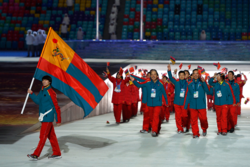
Shangea has long been associated with martial arts, often grouped under the umbrella term Quanfa (拳法). Shangean martial arts are divided into various sects (派; pài) with martial arts often being rooted and inspired by Shangean philosophy. Shangean martial arts generally place emphasis on acrobatics and kicking (such as high kick and flying kicks). Shangean martial arts are encouraged today by all schools with thousands of training facilities and classes around the country.
Cuju was traditionally a popular sport in Shangea being the first mass sport in the country around the late Xiang dynasty. It continued to be practiced widely until the mid 1940's when football started to take its place, thanks partly to the advocacy the National Federation for Football (formed in 1918) gave to the sport. Currently football is by far the most popular sport in Shangea being divided into five leagues - the Premier league, the first league, the second league, the third league, and the local leagues. The Premier league consists of the 16 best football clubs in Shangea, whilst the first league deals with the 25 next best teams. The second league also has 25 teams as does the third league. Teams advance to higher leagues if they are among the top four in the league at the end of the football season, whilst those at the bottom 4 places in the league are relegated to a lower league.
Other popular sports in Shangea include basketball which was introduced to Shangea in the 1960's and is managed by the National Basketball League, ping pong which is the largest amateur sport with Shangea producing famous ping pong players such as Li Jiangguo and badminton. The oldest sport in Shangea, dragon boat racing, is also still practiced with many watching the annual duanwu festival.
Television
Television is popular in Shangea, with the main three television stations - the state-owned Shangean Broadcasting Network (XBN), the free to view Rongzhuo Broadcasting Corporation and the largest cable TV station, TV Shangea. Shangea has a wide range of television programming including children's television, animation, documentaries, music television, news, sport and movies. Television dramas are extremely popular in Shangea, especially those set in historical periods and fantasy romance.
There had been almost no television in Shangea prior to 1947 when the first Xuling Television set was created. There were only three television stations - the Central Shangea Television 1 (ZDX1), the Central Shangea Television 2 (ZDX2) and Shangean Sports (XT). ZDX1 was exclusively broadcast in the Shangean language and aired a broad variety of programming from children television shows, the news and adult dramas whilst the ZXD2 aired similar programming, albeit often programs with lower ratings. XT meanwhile primarily focused on sports programming.
Initially programming was primarily political, mostly taking the form of propaganda films praising the ruling regime - even in the nominally sports centred XT more time was dedicated to political programming. In 1949 the first children's programme - Little Xie Yuanhong - was created, and in 1950 television dramas and comedies were created. Programmes rarely exceeded 20 minutes, and typically television shows lasted for 12 episodes a series. All shows were under strict censorship laws, and so often avoided certain subjects such as politics (or only showed the positive aspects of Shangean history) or religion. Television remained formulaic with most shows being contemporary in nature until the early 1960's, when the first science fiction and historical programmes started to be broadcast alongside documentaries. The XT channel was popular amongst Shangean being less politicised and respected as a reliable and (comparably) uncensored channel for sporting interests. There was an upsurge in the popularity of television in the 1960's and 1970's as programming became more diverse. Initially people appearing on television were also under strict rules. Men were prohibited from wearing beards, and there were a limited number of clothes and haircuts non-political figures could wear on television. Make-up was strictly prohibited. These controls were relaxed during the 1980's, when the first colour televisions were introduced.
in 1985 the ZDX2 and XT were privatised and the state began to allow private networks to be set up. ZDX1 was renamed as the Shangean Broadcasting Network (XBN) as private TV became popular. During the 1970's Shangean drama shows began to become the dominant genre and during the 1990's there was a notable increase in production values and script quality.
Theatre and Dance
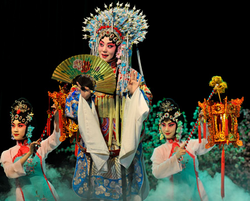
Traditional Shangean opera has developed over centuries to combine music, vocal performance, mime, dance, and acrobatics within it. The earliest Shangean theatrical performances during the early Xiang dynasty were based on "mask performance" (面具表演; miànjù biǎoyǎn) which were silent mime performances that were played in the royal court. Travelling performers would often act plays in villages that were based in folklore with dialogue spoken in verse, but these shows were for a long time seen as vulgar.
During the mid-Xiang dynasty zaju (雜劇) performances became popular, with the roles within performances started to be separated between the sheng (生; male characters) dan (旦; female characters) jing (净; painted face male often but not always in a supporting role) and chou (丑; male clown and always a minor or supporting character). By the Tao dynasty elements of acrobatics and dialogue began to be common in Shangean theatre. Increasingly musical elements and singing was added to performances with the main instruments being used being jinghu's and yueqin's.
Under the Toki dynasty elements of kabuki influenced Shangean theatre, in particular a use of makeup over traditional masks and performances that often lasted full days. The Heavenly Shangean Empire saw the height of Shangean opera which began to exhibit plays based in history, mythology and contemporary life. Shangean opera continued to be popular until the 1960's when the popularity of films started to surpass it. Since then there has been moves to change Shangean opera (such as importing Euclean theatrical techniques, shortening the length of plays and putting greater focus on contemporary plays) to mixed success.




